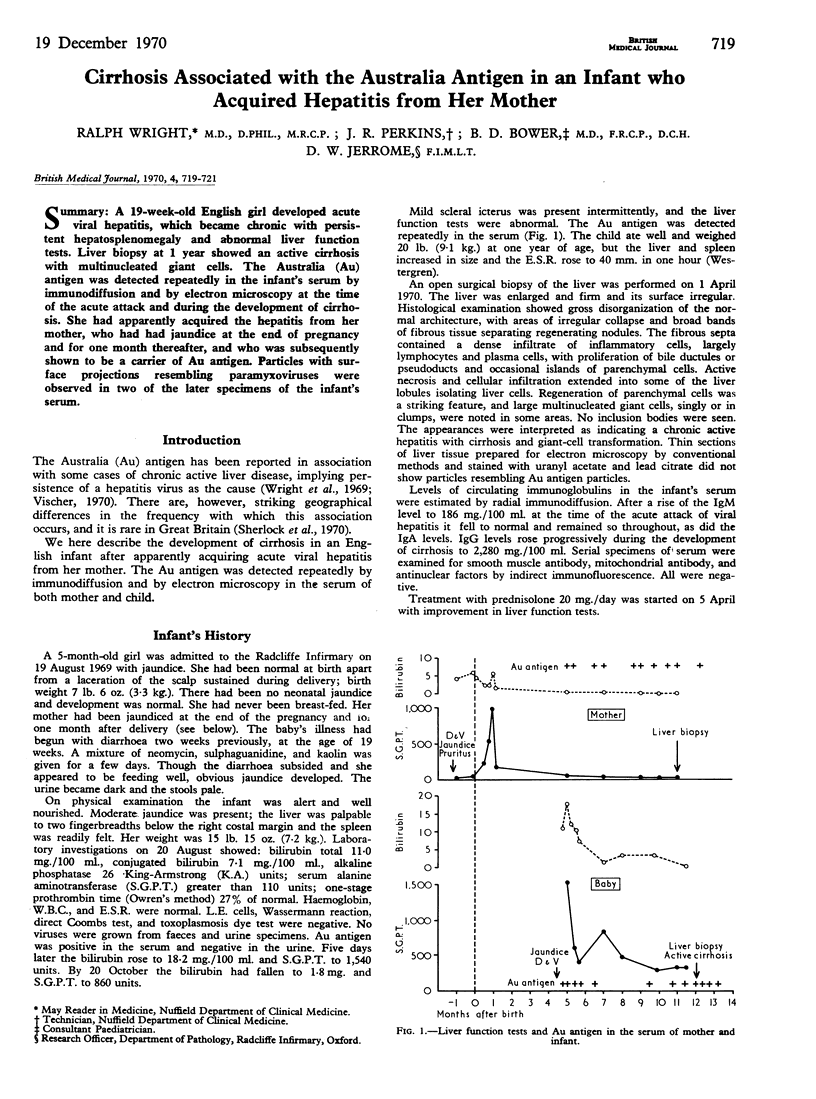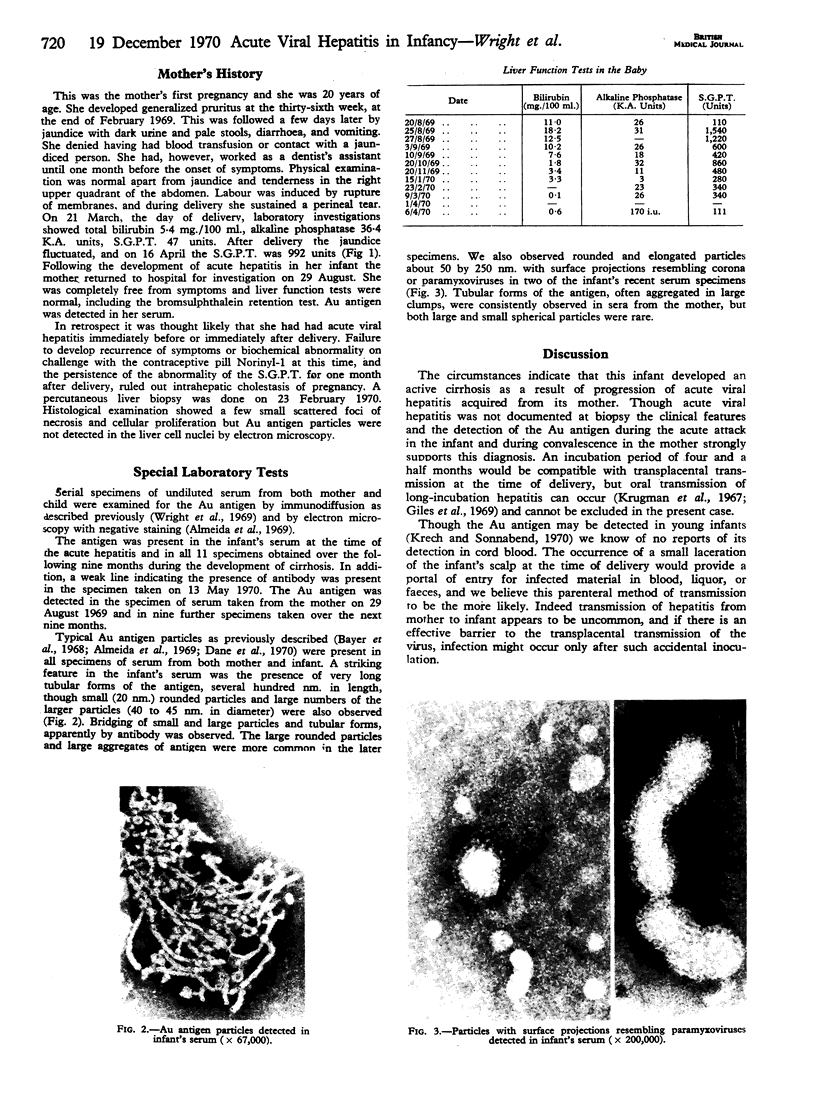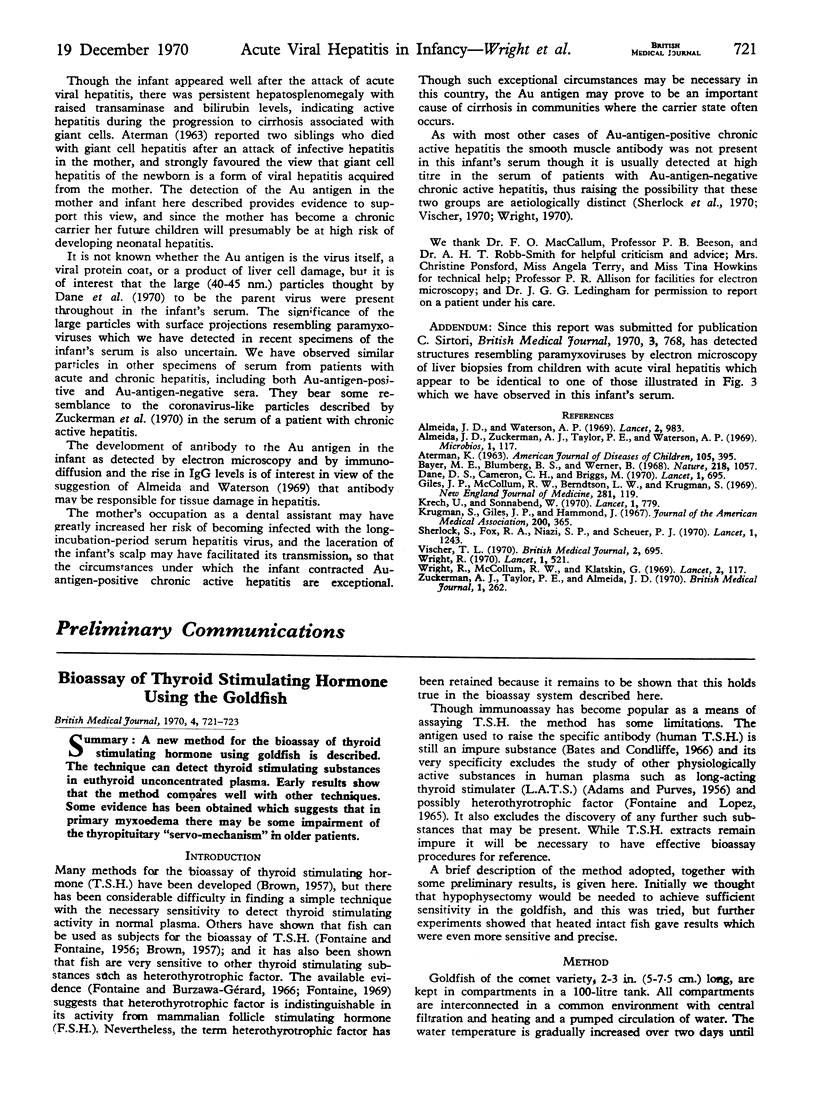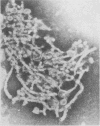Abstract
A 19-week-old English girl developed acute viral hepatitis, which became chronic with persistent hepatosplenomegaly and abnormal liver function tests. Liver biopsy at 1 year showed an active cirrhosis with multinucleated giant cells. The Australia (Au) antigen was detected repeatedly in the infant's serum by immunodiffusion and by electron microscopy at the time of the acute attack and during the development of cirrhosis. She had apparently acquired the hepatitis from her mother, who had had jaundice at the end of pregnancy and for one month thereafter, and who was subsequently shown to be a carrier of Au antigen. Particles with surface projections resembling paramyxoviruses were observed in two of the later specimens of the infant's serum.
Full text
PDF


Images in this article
Selected References
These references are in PubMed. This may not be the complete list of references from this article.
- ATERMAN K. Neonatal hepatitis and its relation to viral hepatitis of mother. A review of the problem. Am J Dis Child. 1963 Apr;105:395–416. doi: 10.1001/archpedi.1963.02080040397014. [DOI] [PubMed] [Google Scholar]
- Almeida J. D., Waterson A. P. Immune complexes in hepatitis. Lancet. 1969 Nov 8;2(7628):983–986. doi: 10.1016/s0140-6736(69)90540-6. [DOI] [PubMed] [Google Scholar]
- Bayer M. E., Blumberg B. S., Werner B. Particles associated with Australia antigen in the sera of patients with leukaemia, Down's Syndrome and hepatitis. Nature. 1968 Jun 15;218(5146):1057–1059. doi: 10.1038/2181057a0. [DOI] [PubMed] [Google Scholar]
- Dane D. S., Cameron C. H., Briggs M. Virus-like particles in serum of patients with Australia-antigen-associated hepatitis. Lancet. 1970 Apr 4;1(7649):695–698. doi: 10.1016/s0140-6736(70)90926-8. [DOI] [PubMed] [Google Scholar]
- Giles J. P., McCollum R. W., Berndtson L. W., Jr, Krugman S. Relation of Australia-SH antigen to the willowbrook MS-2 strain. N Engl J Med. 1969 Jul 17;281(3):119–122. doi: 10.1056/NEJM196907172810302. [DOI] [PubMed] [Google Scholar]
- Krech U., Sonnabend W. Australia antigen in newborn babies. Lancet. 1970 Apr 11;1(7650):779–779. doi: 10.1016/s0140-6736(70)91008-1. [DOI] [PubMed] [Google Scholar]
- Krugman S., Giles J. P., Hammond J. Infectious hepatitis. Evidence for two distinctive clinical, epidemiological, and immunological types of infection. JAMA. 1967 May 1;200(5):365–373. doi: 10.1001/jama.200.5.365. [DOI] [PubMed] [Google Scholar]
- Sherlock S., Fox R. A., Niazi S. P., Scheuer P. J. Chronic liver disease and primary liver-cell cancer with hepatitis-associated (Australia) antigen in serum. Lancet. 1970 Jun 13;1(7659):1243–1247. doi: 10.1016/s0140-6736(70)91737-x. [DOI] [PubMed] [Google Scholar]
- Vischer T. L. Australia antigen and autoantibodies in chronic hepatitis. Br Med J. 1970 Jun 20;2(5711):695–698. doi: 10.1136/bmj.2.5711.695. [DOI] [PMC free article] [PubMed] [Google Scholar]
- Wright R. Australia antigen and smooth-muscle antibody in acute and chronic hepatitis. Lancet. 1970 Mar 7;1(7645):521–522. doi: 10.1016/S0140-6736(70)91605-3. [DOI] [PMC free article] [PubMed] [Google Scholar]
- Wright R., McCollum R. W., Klatskin G. Australia antigen in acute and chronic liver disease. Lancet. 1969 Jul 19;2(7612):117–121. doi: 10.1016/s0140-6736(69)92437-4. [DOI] [PubMed] [Google Scholar]
- Zuckerman A. J., Taylor P. E., Almeida J. D. Presence of particles other than the Australia-SH antigen in a case of chronic active hepatitis with cirrhosis. Br Med J. 1970 Jan 31;1(5691):262–264. doi: 10.1136/bmj.1.5691.262. [DOI] [PMC free article] [PubMed] [Google Scholar]




